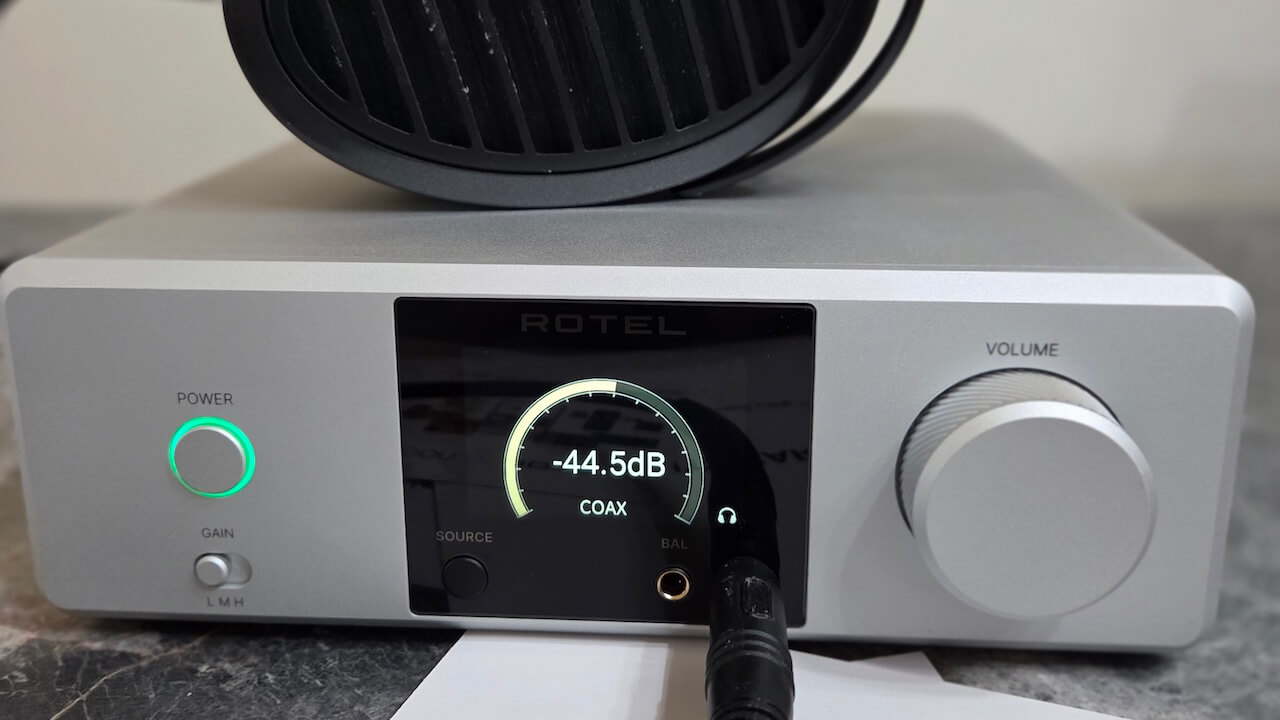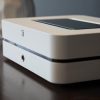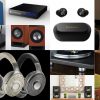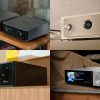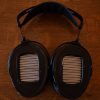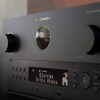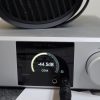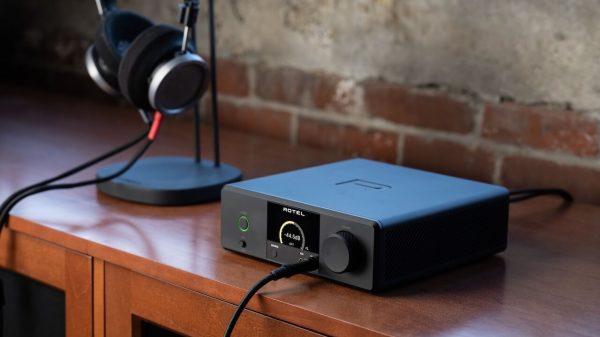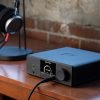Rotel’s new DX-3 isn’t just another DAC/amp combo trying to squeeze into an already crowded desktop—it’s a fully loaded control center for your headphone rig or powered speaker setup. With native support for 32-bit/384kHz PCM, DSD up to 4X, and Bluetooth aptX HD, it cuts down the clutter while giving you serious digital cred. You get PC-USB input (with that high-res DSD 256 support), coax and optical inputs at 24/192, plus both RCA and XLR outputs so you’re covered whether you’re running cans, actives, or both. It’s compact, slick, and checks every box the modern listener needs without dragging a stack of boxes into the room.
Rotel used to be the industry’s best-kept secret—a behind-the-scenes powerhouse quietly building key components and entire products for major brands like Marantz, Scott, and Harmon Kardon. In the 1960s and ’70s, their expertise was everywhere, even if their name wasn’t. That all changed in 1973 when their RX-402 receiver snagged Consumer Reports’ Best Buy award—followed by second and third place going to receivers built by Rotel but sold under other badges. It was a full sweep, a quiet but undeniable statement of their engineering prowess.
However, in recent decades, Rotel has stumbled a bit in carving out a clear identity. With an evolving audio market flooded by affordable, feature-packed gear from Asia and stiff competition from the established old guard, Rotel’s place has sometimes felt uncertain. Their branding didn’t always keep pace with these shifts, leaving them caught between premium heritage and mid-range expectations.
Fast forward to today, and Rotel is stepping out from the shadows with a bold new identity. Their recent Michi series shattered expectations by marrying high-end design with serious audio performance, showing the world they’re ready to play in the luxury league. No longer content to be the silent partner, Rotel’s latest lineup—including the DX-5 integrated amp with high-performance DAC, the versatile A8 integrated amplifier, and the Michi Q5 transport DAC capable of 32-bit/384kHz and DSD playback—signals a major shift.
They’re embracing innovation and flexibility, proving they can deliver cutting-edge tech without losing the reliability and craftsmanship that made them a legend. This new wave of Rotel gear isn’t just evolution—it’s a statement that they’re here to compete on every front.
The DX-3? It’s the latest evidence. Smartly designed, technically proficient, and deeply rooted in a legacy of building gear that performs far beyond expectations—even if someone else used to take the credit.
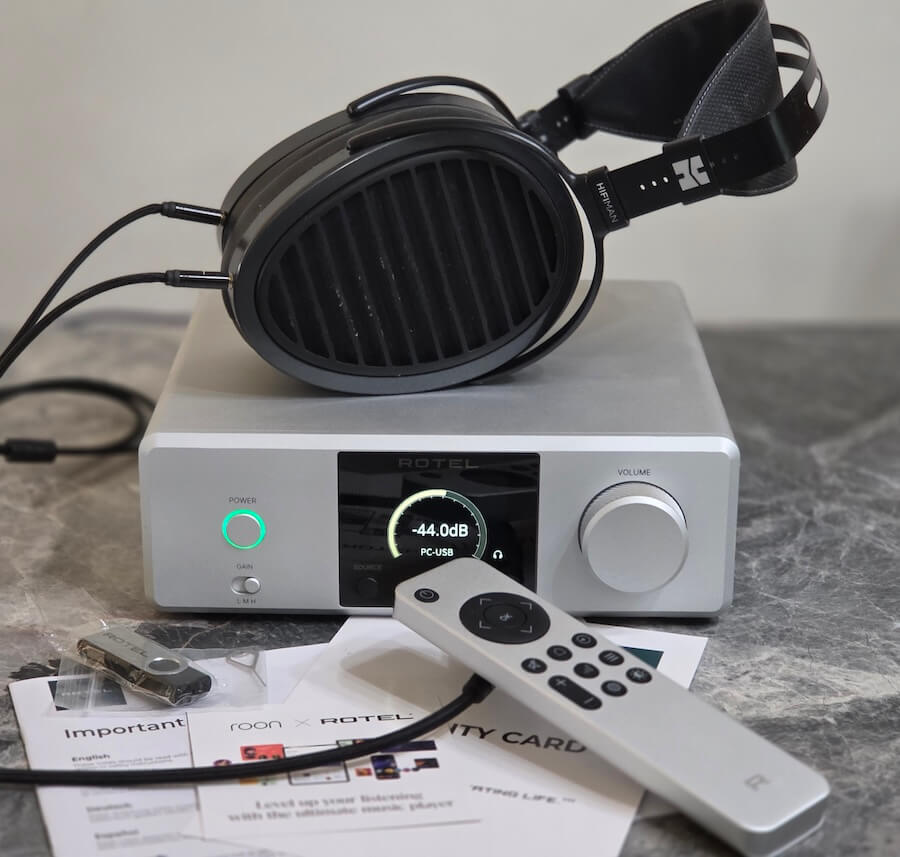
Unboxing the Rotel DX-3: Heavy Metal, Hidden Brains, and a Power Supply That Means Business
Cracking open the Rotel DX-3’s packaging is an experience that walks a fine line between luxury and low-key intimidation. The first thing that hit me—literally—was the weight. Before you even see the unit, you’ll clock the heft lifting the inner box out of the shipping carton. My immediate reaction? Mild panic. “If the box is this big, how big is the actual unit—and where the hell am I putting it on my desk?”
Fortunately, the internal layout quickly eased those fears. The magnetic lid opens to reveal a tidy, well-thought-out arrangement: the DX-3 itself, wrapped in an anti-static bag and nestled in a thick foam cradle, takes up most of the space. A side compartment houses the power cable and remote, and between that and the generous ½” to ¾” foam padding all around, you realize most of that box is just smart packaging. The unit itself clocks in at a desktop-friendly 8½” wide, 9¾” deep, and 2¾” tall.
But the weight? That’s still very real—over 7 lbs (3.2 kg) of desktop density. I couldn’t help myself. I did something I haven’t done in a while: I cracked it open to see where all that mass was hiding.
Spoiler alert: it’s not just a vanity move. Some brands bulk up their gear with thick metal casings for the illusion of quality. Not here. The case is solid enough for stability, but it’s mostly under 2mm thick—except for the front panel, which beefs up to around 5mm at the edges. The real story is what’s inside.
Sitting dead left is a toroidal transformer that could moonlight as gym equipment. This thing is the weight culprit, and it’s not some off-the-shelf job—it’s hand-wound and purpose-built for the DX-3. If you know your Rotel history, you know this isn’t new territory. They’ve been overbuilding power supplies since the ’60s, and clearly haven’t lost their touch.
Plenty of modern DAC/headphone amps are powered by wall warts and hope. The DX-3? It’s got a dedicated toroidal power plant that probably weighs more than some entire competing units. It’s old-school engineering in a sleek new-school wrapper—and it makes a statement before you even power it on.
Having jumped straight into the guts of the DX-3 before even giving the exterior its due might seem like putting the cart before the horse—but let’s be honest, with Rotel, it kind of makes sense. This is a company that’s always prioritized substance over style. That’s not to say the DX-3 is unattractive—it’s just refreshingly utilitarian, like a piece of gear that knows exactly what it’s here to do and doesn’t waste time with flash.
Up front, the layout is clean and intuitive. You’ve got a power button stacked above the gain switch on the left, a central display that’s just the right size (not some overdone OLED trying to be an iPad), and beneath it, both a 4.4mm balanced and a 6.35mm single-ended headphone jack. Over on the right sits the main volume knob—large, smooth, and reassuringly solid.
The rear panel is where things start to get busy, but not cluttered. Far left, there’s a pair of XLR balanced outputs, followed by standard RCA outs and a pair of RCA inputs. The digital input section is cleanly stacked: coaxial and the Bluetooth antenna sit up top, while optical, USB-B, and a 3.5mm service port sit below. Power duties are handled far right, where a physical power switch lives above a fuse socket and the NEMA C14 connector for standard AC.
Ventilation is thoughtfully designed—left side only, with the top, right, and bottom sealed up. That means placement matters. You’ll want to leave some breathing room on the left side, especially if you plan to stack it with other gear or run it hard for long sessions.
And then there’s the remote—a detail many manufacturers phone in, but not Rotel. The DX-3’s remote is a slim, machined aluminum unit with actual buttons (imagine that!) and a simple, sensible layout. You don’t need a decoder ring to figure out what anything does, and everything just works. I’ve lost track of how many otherwise premium components arrive with a plastic remote that looks like it was liberated from a ‘90s DVD player bargain bin. If you’re going to include a remote, at least make it feel like it belongs with the product. Rotel clearly got the memo.
So yes, the DX-3 is visually restrained and tactically efficient. Nothing flashy. But then again, the real fireworks are under the hood—which, frankly, is where they should be.
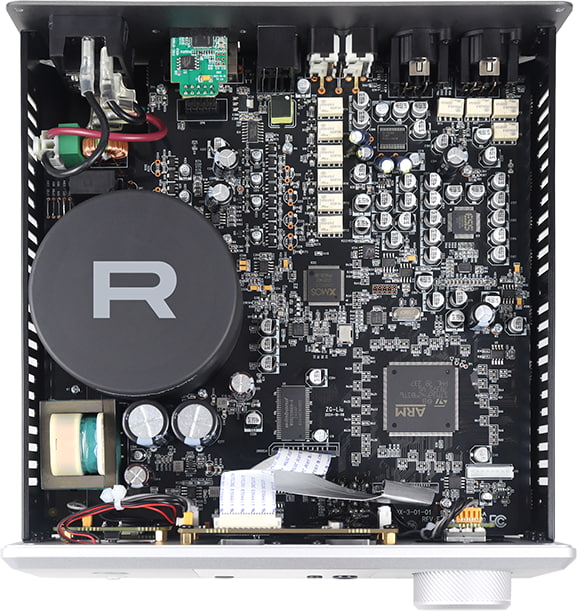
Under the Hood: Rotel’s Sonic Muscle and DIY Obsession
Here’s where things get nerdy—in the best way. Rotel didn’t just phone in a spec sheet and bolt in off-the-shelf parts like it was building a budget streamer. The DX-3 takes the scenic route, starting with a custom-wound toroidal transformer that doesn’t just supply power—it defines it. That toroid isn’t just there for weight bragging rights; it’s part of a dual-power architecture that completely separates the analog and digital domains, each fed by its own dedicated power supply. Translation? Far less chance of digital noise creeping into the analog signal path and wrecking your listening session.
But Rotel didn’t stop at overbuilding the power section. The brand also manufactures most of its own capacitors in-house. That might sound like trivia, but it’s not. While most companies are out here playing the parts lottery with whatever Mouser or Digi-Key happens to have in stock, Rotel’s designing capacitors to fit the circuit, not the shipping container. It’s boutique behavior—at scale.
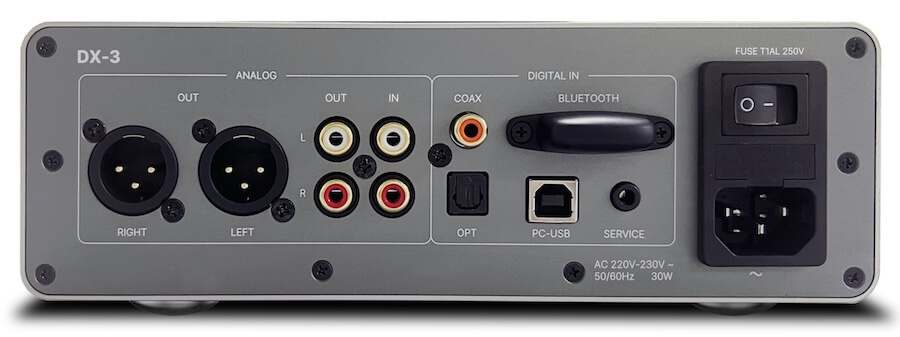
Input-wise, the DX-3 covers nearly all bases:
- USB supports up to 32-bit/384kHz PCM and DSD256 (DSD 4X),
- Coaxial and Optical inputs handle 24-bit/192kHz PCM,
- Analog RCA in for your favorite pre-digital source,
- Bluetooth via Qualcomm with aptX HD, AAC, and (if you’re really desperate) SBC.
So whether you’re running a streamer, spinning vinyl, or just slumming it with your phone, the DX-3 has you covered—without resorting to input gymnastics every time you switch sources.
Feeding this digital banquet into your ears is an ESS ES9028Pro 8-channel DAC—yes, the same chip used in some significantly pricier units. Rotel uses channel summing to improve dynamic range and lower THD+N, and adds its own low-pass filtering to squeeze even more silence between the notes.
From there, the signal moves into a fully balanced, fully differential amp circuit that’s got enough muscle to drive nearly anything short of electrostatics. Numbers? Sure:
- 765mW @ 16Ω (single-ended)
- 2.8W @ 16Ω (balanced)
- 41mW @ 300Ω (single-ended)
- 150mW @ 300Ω (balanced)
Not bad for a desktop unit that isn’t trying to set your table on fire.
You get three gain levels to tailor output to your headphones’ sensitivity, and the output stage feeds through an NJW1195A volume attenuator that adjusts in fine 0.5dB increments—none of that herky-jerky “loud/way too loud” volume ramp here.
And output impedance? Less than 0.3Ω single-ended and 0.6Ω balanced. Which means it plays nice with everything from IEMs to full-size planars without screwing with the frequency response. In short, the DX-3 doesn’t just show up—it comes armed to the teeth.
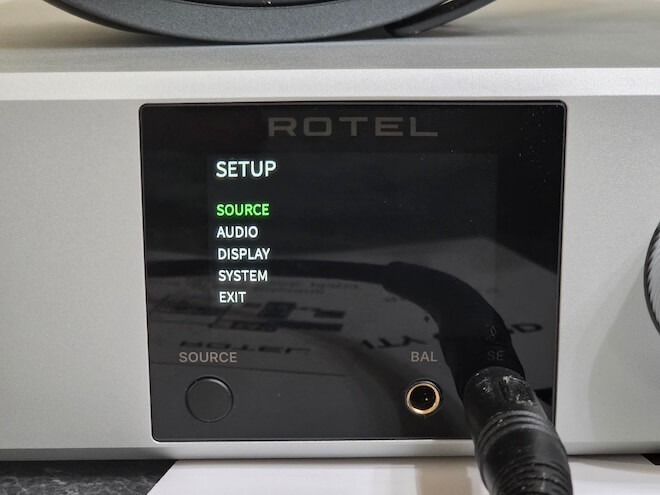
Functions & Controls: Set It and Forget It (Until You Want to Tweak Everything)
Setting up the Rotel DX-3 is refreshingly drama-free—no mysterious button combinations, no driver voodoo (on macOS, at least), and no menus buried five clicks deep just to change the input. I had USB from my laptop, optical from an SACD transport, and Bluetooth from my phone hooked up in under five minutes. Outputs? XLR into a pair of Adam Audio A7Vs, plus a rotating cast of headphones and IEMs via the 4.4mm balanced and 6.35mm single-ended jacks up front.
After plugging the DX-3 into a line conditioner (because why not feed an overbuilt toroidal transformer the cleanest power possible?), I flipped the rear power switch, dropped a couple of AAAs into the remote, and was off to the races.
A soft green halo around the power button lets you know the DX-3 is in standby. Turn it on and the display wakes up with the Rotel logo before jumping into a clean UI: a large semicircle volume indicator that fills yellow like a retro-futuristic fuel gauge, with the numerical dB level smack in the middle. Below that, the current input source is shown clearly—no need to squint or guess whether you’re on USB or Coax.
Source switching? One tap on the front panel or the remote. Simple. No need to scroll endlessly or decipher cryptic abbreviations. The large volume knob is satisfyingly tactile—it turns with a touch of resistance that screams “precision” without feeling stiff. Bonus points for not being one of those loose, wobbly knobs that feels like it was lifted from a $30 streaming box.
A couple of UI quirks worth noting:
There’s no visual indication when you change the gain. You have to peek at the slider switch next to the power button, which feels like an oversight on an otherwise polished interface.
The DAC format indicator (PCM or DSD) only shows up after the unit is actively decoding a signal. Same goes for the headphone icon in the bottom-left corner—it appears only when a headphone is actually plugged in.
Not a dealbreaker, but a touch more display feedback wouldn’t have hurt, especially for folks toggling between sensitive IEMs and planar headphones.
That said, once it’s up and running, the DX-3 is about as plug-and-play as high-end digital audio gets—unless you’re the type who needs to know exactly what capacitor is in the output stage. In which case… you probably bought this already.
The Remote: Necessary Evil or Underrated Hero?
Look, the DX-3’s front panel does the heavy lifting just fine—but don’t toss that remote in a drawer just yet. There are a handful of critical functions that are remote-only, and if you’re the kind of person who loses remotes faster than left socks in the dryer, you’ll want to keep this one close.
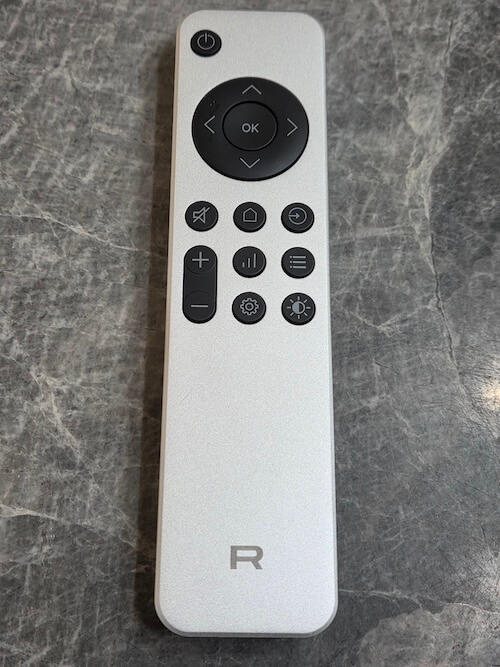
For starters: mute. There’s no mute button on the unit itself—so if you want to silence things quickly, you’d better have the remote handy or prepare to spin that volume dial like a contestant on The Price Is Right. Also tied to the remote are the screen dimming, file info display, and setup menu access, none of which are accessible via the unit’s front panel. If you’re running the DX-3 in a dark room or studio, being able to kill or dim that display without getting up is a small but real luxury.
Some buttons are a bit more cryptic:
- The “Home” button does nothing if you’re already on the main screen—but if you’ve drilled into settings or file info, it’s your exit hatch.
- The “Function” button toggles between peak dB readout and a live spectrum analyzer during playback. Audiophile light show? Sure. But it’s actually useful for quick signal checks.
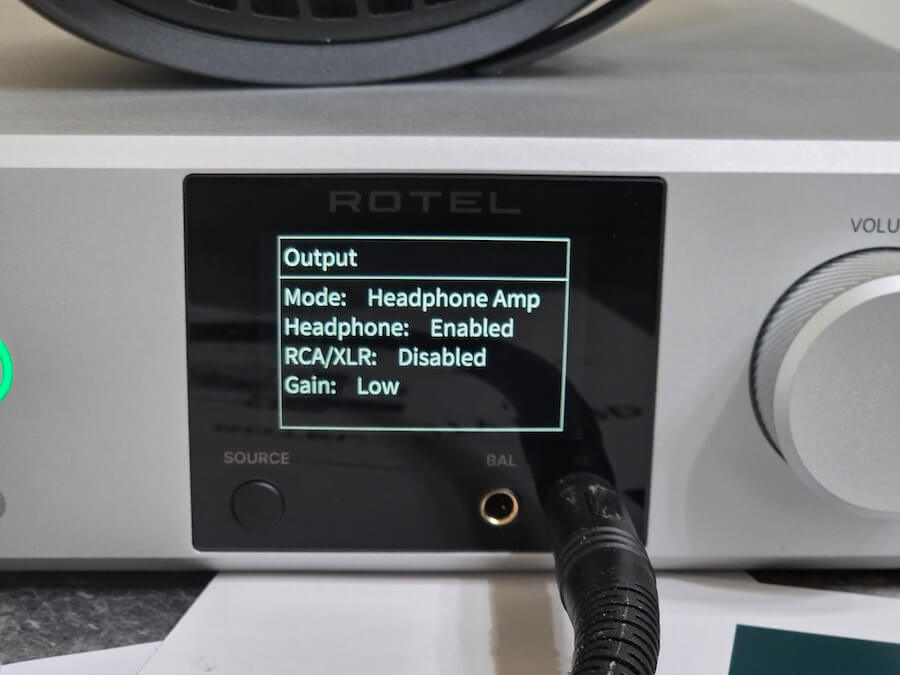
Now let’s talk about a real feature worth knowing: the Audio Mode toggle in the setup menu. You get two choices:
- Headphone Amplifier mode, which engages the volume control and front headphone outputs.
- DAC mode, which disables volume control and headphone outputs entirely—perfect for fixed-level output to powered speakers or an external preamp.
Use case matters. If you, like me, are running this into powered monitors and still want volume control from the DX-3, leave it in Headphone Amplifier mode. Otherwise, prepare to reach behind your speakers every time you want to nudge the volume.
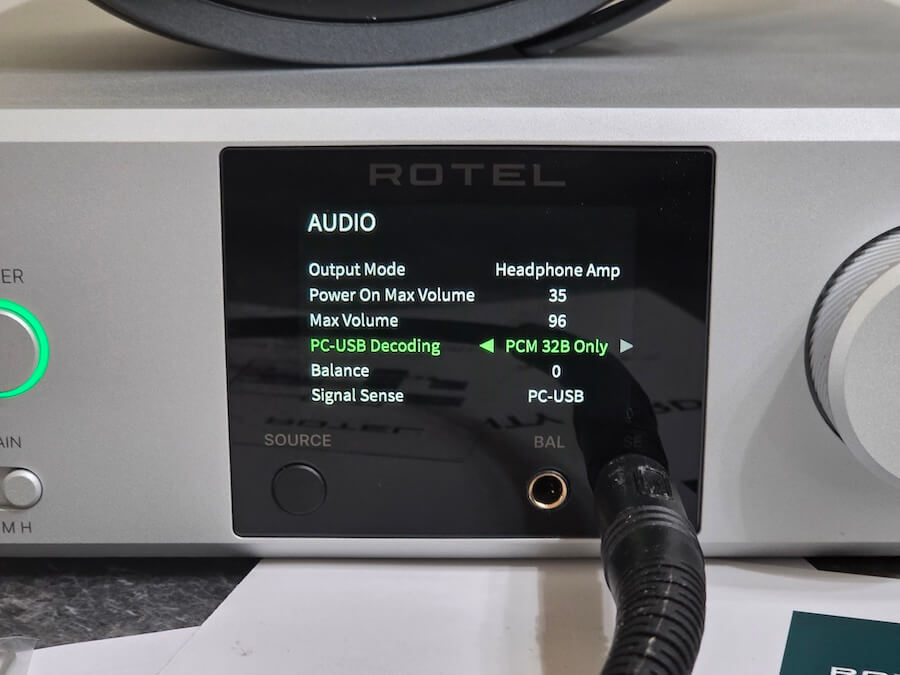
One final quirk worth mentioning for Windows users: the DX-3 only enumerates as a USB DAC if USB is selected as the active input. If you’re on Coax or Optical, Windows won’t detect it as an audio device. This isn’t uncommon among serious audio gear that prioritizes signal path integrity over convenience, but if you’re used to DACs that always keep the USB handshake alive, this might trip you up at first.
Bottom line: the remote may not be flashy, but it’s the key to unlocking some of the DX-3’s smarter features—and understanding when and how to use it makes the difference between living with the unit and actually mastering it.
Listening Impressions: Does the Rotel DX-3 Actually Deliver?
Once everything was wired up, I ran the Rotel DX-3 through a gauntlet of familiar gear, starting with the Sennheiser HD 650 (300Ω), Audeze MM-500 (18Ω), and Fostex TH-X00 (25Ω). I also tested a lineup of IEMs: Campfire Andromeda (12.8Ω), Ultimate Ears Premier (10Ω), and Westone Mach 70 (42Ω). All fell squarely within the DX-3’s comfort zone. I ran them on mid gain, rarely pushing the volume past 50%. The DX-3 offered dead-silent backgrounds, plenty of headroom, and the kind of neutral, transparent presentation you’d expect from a serious piece of kit. No warmth added, no sparkle faked—just clean, controlled output.
Then I got bold. I threw on the AKG K240 DF (600Ω) and Beyerdynamic DT880 (600Ω), followed by two notoriously power-hungry planars: the HiFiMAN Susvara Unveiled (60Ω, 83dB/mW) and HiFiMAN HE-6 (50Ω, ~83.5dB/mW). This is where most portable DAC/amps start to sweat—and to be fair, so did the DX-3, just a little. The 600-ohm dynamics played reasonably well at high gain with the volume north of 70%, though they clearly weren’t operating at full throttle. The Susvara and HE-6? Usable, yes, but the DX-3 isn’t the hammer you need to really make those shine.
In-Ear Headphone Performance: How the DX-3 Handles the Low-Impedance Crew
The in-ears weren’t a uniform experience. The Campfire Andromeda (12.8Ω) demanded low gain and barely any volume to hit listening levels—any more and hiss showed up loud and clear. Not surprising, since it’s below the recommended impedance range and famously hiss-prone, but it does confirm pushing the lower limit isn’t pretty.
The UE Premier (15Ω) skirts just inside that lower impedance boundary and performed a bit better. It also needed minimal volume and gain, but had a noticeably darker noise floor at normal levels. Crank the gain or volume, though, and hiss creeps in—especially obvious between tracks.
The Westone Mach 70 (42Ω) was more comfortable territory. It worked well on low or mid gain, but I preferred mid gain with a slightly lower volume to leave room for headroom. The Mach 70’s signature big bass and vivid lower treble came through cleanly, and the DX-3 let it show off without bottleneck or noise.
Pushing the High-Impedance Limits and Preamp Performance: The DX-3 in the Real World
At the upper end, the Beyerdynamic DT880 (600Ω) was surprisingly well-behaved. Sure, it demanded high gain, but the DX-3 still had plenty of headroom left on the volume knob—enough to crank it past recommended levels if you’re into that sort of thing.
The AKG 240 (also 600Ω, realistically closer to 630Ω) can be notorious for triggering dongles to switch to line-out mode, but the DX-3 took it in stride. More gain and volume were needed compared to low-impedance sets, but clarity and balance stayed rock solid.
The HiFiMAN planars split the room. The Susvara showed its high-power appetite—lacking impact and clarity in the lows and leaving little volume range above normal listening levels. No shocker there, since HiFiMAN recommends 8–10 watts to drive it properly. The HE-6 was too much for the single-ended output but came alive balanced, delivering enough volume and room to spare for softer recordings.
Switching over to the Adam Audio A7V monitors, the DX-3 proved its chops as a preamp. Volume steps were finely tuned—none of that jumpy “too loud or too quiet” nonsense some devices serve up. The volume knob was smooth, crackle-free, and perfectly matched across its entire range—even in the lowest quarter where other amps often falter with imbalance or noise. This wasn’t just a headphone amp with a preamp slapped on; it’s a proper two-headed beast designed to nail both roles without compromise.
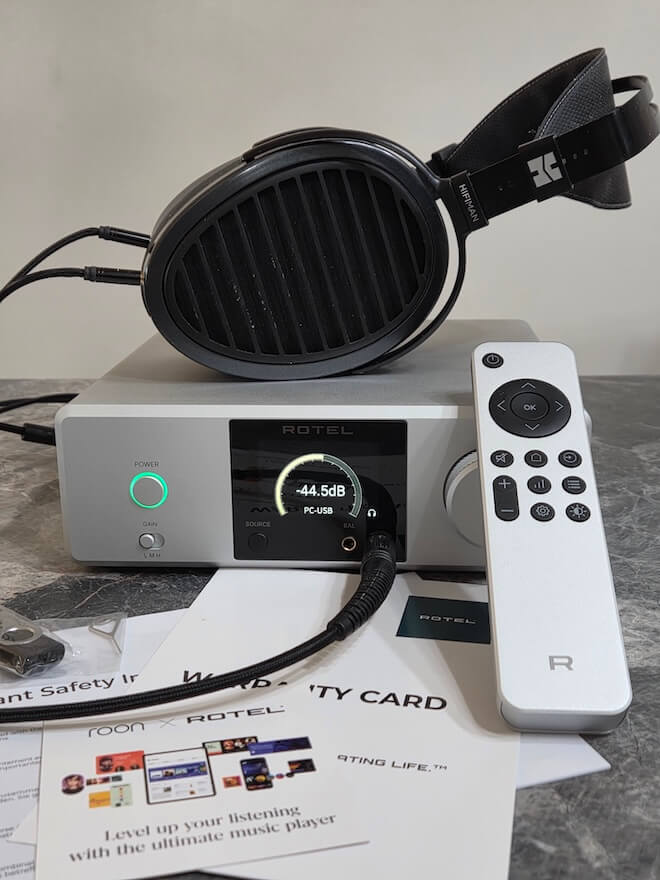
The Bottom Line: Rotel DX-3 — Built to Last, Built to Perform
At $1499, the DX-3 might raise eyebrows in a market crowded with cheaper DACs and headphone amps. It doesn’t flaunt the latest “exotic” DAC chip or an eye-popping specs sheet. What it does have is a meticulously engineered core, purpose-built with premium, custom components designed to deliver consistent, transparent sound and rock-solid reliability.
The DX-3 isn’t just a headphone amp or a DAC; it’s a versatile, all-in-one audio hub that easily doubles as a preamp for powered monitors. The controls and remote are intuitive and well-made, letting you switch sources, adjust volume, and tweak settings without fuss. Multiple screen dimming levels prove thoughtful for bedroom or shared space use.
Sure, you can find cheaper gear, but most don’t offer Rotel’s build quality, long-term support, or a five-year warranty. That’s a meaningful investment in longevity and peace of mind—especially compared to those flavor-of-the-month devices with short lifespans and questionable parts availability.
In terms of usability and performance, the DX-3 handles everything from low-impedance in-ears to demanding high-impedance headphones without breaking a sweat. The preamp function works smoothly, offering clean, crackle-free volume control for powered speakers.
If you want a solid, no-nonsense all-in-one headphone system that won’t need replacing any time soon—and performs at a level that justifies its price—the Rotel DX-3 is well worth your attention. It’s built to last, and built to deliver.
Where to buy:
For more information: rotel.com
Related Reading:
- STAX SRM-400S Electrostatic Headphone Amplifier Review
- Rotel’s DX-5 Is A Compact Audiophile Integrated Amp With A High-Performance DAC
- Rotel’s DX-3 DAC/Headphone Amplifier Doubles As A Preamp With Active Speakers
- JDS Labs Element IV DAC/AMP Review
- iFi iDSD Valkyrie DAC/Headphone Amp Review: Futureproof Powerhouse or Feature Fatigue?

